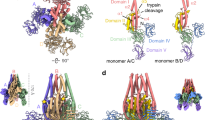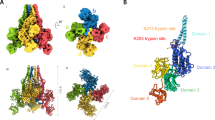Abstract
Bacillus thuringiensis vegetative insecticidal proteins like Vip3A have been used for crop protection and to delay resistance to existing insecticidal Cry toxins. However, little is known about Vip3A’s behavior or its mechanism of action, and a structural model is required. Herein, in an effort to facilitate future crystallization and functional studies, we have used the orthogonal biophysical techniques of light scattering and sedimentation to analyze the aggregation behavior and stability of trypsin-activated Vip3A toxin in solution. Both scattering and sedimentation data suggest that at pH 10 the toxin is monomeric and adopts an elongated shape, but after overnight incubation aggregation was observed at all pH values tested (5–12). The narrowest size distribution was observed at pH 7, but it was consistent with large oligomers of ~50 nm on average. The addition of β-d-glucopyranoside (OG) helped in achieving preparations that were stable and with a narrower particle size distribution. In this case, scattering was consistent with a 4-nm monomeric globular Vip3A form. After OG dialysis, 40-nm particles were detected, with a molecular weight consistent with homotetramers. Therefore, OG is proposed as the detergent of choice to obtain a Vip3A crystal for structural studies, either before (monomers) or after dialysis (tetramers).





Similar content being viewed by others
References
Abdelkefi-Mesrati L, Boukedi H, Chakroun M, Kamoun F, Azzouz H, Tounsi S, Rouis S, Jaoua S (2011) Investigation of the steps involved in the difference of susceptibility of Ephestia kuehniella and Spodoptera littoralis to the Bacillus thuringiensis Vip3Aa16 toxin. J Invertebr Pathol 107:198–201
Barth H, Aktories K, Popoff MR, Stiles BG (2004) Binary bacterial toxins: biochemistry, biology, and applications of common Clostridium and Bacillus proteins. Microbiol Mol Biol Rev 68:373–402
Chakroun M, Bel Y, Caccia S, Abdelkefi-Mesrati L, Escriche B, Ferre J (2012) Susceptibility of Spodoptera frugiperda and S. exigua to Bacillus thuringiensis Vip3Aa insecticidal protein. J Invertebr Pathol 110:334–339
Chakroun M, Banyuls N, Bel Y, Escriche B, Ferre J (2016) Bacterial vegetative insecticidal proteins (Vip) from entomopathogenic bacteria. Microbiol Mol Biol Rev 80:329–350
Christeller JT, Laing WA, Markwick NP, Burgess EPJ (1992) Midgut protease activities in 12 phytophagous lepidopteran larvae: dietary and protease inhibitor interactions. Insect Biochem Mol Biol 22:735–746
Crickmore N, Zeigler DR, Feitelson J, Schnepf E, Van Rie J, Lereclus D, Baum J, Dean DH (1998) Revision of the nomenclature for the Bacillus thuringiensis pesticidal crystal proteins. Microbiol Mol Biol Rev 62:807–813
Crickmore N, Schnepf E, Van Rie J, Lereclus D, Baum J et al (2011) Bacillus thuringiensis toxin nomenclature:[WWW document]. http://www.lifesci.sussex.ac.uk/Home/Neil_Crickmore/Bt/
Estruch JJ, Warren GW, Mullins MA, Nye GJ, Craig JA, Koziel MG (1996) Vip3A, a novel Bacillus thuringiensis vegetative insecticidal protein with a wide spectrum of activities against lepidopteran insects. Proc Natl Acad Sci USA 93:5389–5394
Estruch JJ, Koziel MG, Yu CG, Desai NM, Nye GJ, Warren GW (1998) Plant pest control. Patent WO 9844137
Ferre J, Van Rie J (2002) Biochemistry and genetics of insect resistance to Bacillus thuringiensis. Annu Rev Entomol 47:501–533
Finley D (1971) Probit analysis, 3rd edn. Cambridge University Press, London, UK
Han S, Craig JA, Putnam CD, Carozzi NB, Tainer JA (1999) Evolution and mechanism from structures of an ADP-ribosylating toxin and NAD complex. Nat Struct Biol 6:932–936
Lee MK, Walters FS, Hart H, Palekar N, Chen JS (2003) The mode of action of the Bacillus thuringiensis vegetative insecticidal protein Vip3A differs from that of Cry1Ab delta-endotoxin. Appl Environ Microbiol 69:4648–4657
Lee MK, Miles P, Chen JS (2006) Brush border membrane binding properties of Bacillus thuringiensis Vip3A toxin to Heliothis virescens and Helicoverpa zea midguts. Biochem Biophys Res Commun 339:1043–1047
Liu JG, Yang AZ, Shen XH, Hua BG, Shi GL (2011) Specific binding of activated Vip3Aa10 to Helicoverpa armigera brush border membrane vesicles results in pore formation. J Invertebr Pathol 108:92–97
Mesrati LA, Tounsi S, Jaoua S (2005) Characterization of a novel vip3-type gene from Bacillus thuringiensis and evidence of its presence on a large plasmid. FEMS Microbiol Lett 244:353–358
Milne R, Liu Y, Gauthier D, van Frankenhuyzen K (2008) Purification of Vip3Aa from Bacillus thuringiensis HD-1 and its contribution to toxicity of HD-1 to spruce budworm (Choristoneura fumiferana) and gypsy moth (Lymantria dispar) (Lepidoptera). J Invertebr Pathol 99:166–172
Moellenbeck DJ, Peters ML, Bing JW, Rouse JR, Higgins LS, Sims L, Nevshemal T, Marshall L, Ellis RT, Bystrak PG, Lang BA, Stewart JL, Kouba K, Sondag V, Gustafson V, Nour K, Xu D, Swenson J, Zhang J, Czapla T, Schwab G, Jayne S, Stockhoff BA, Narva K, Schnepf HE, Stelman SJ, Poutre C, Koziel M, Duck N (2001) Insecticidal proteins from Bacillus thuringiensis protect corn from corn rootworms. Nat Biotechnol 19:668–672
Palma L, Hernandez-Rodriguez CS, Maeztu M, Hernandez-Martinez P, Ruiz de Escudero I, Escriche B, Munoz D, Van Rie J, Ferre J, Caballero P (2012) Vip3C, a novel class of vegetative insecticidal proteins from Bacillus thuringiensis. Appl Environ Microbiol 78:7163–7165
Palma L, Munoz D, Berry C, Murillo J, Caballero P (2014) Bacillus thuringiensis toxins: an overview of their biocidal activity. Toxins (Basel) 6:3296–3325
Rang C, Gil P, Neisner N, Van Rie J, Frutos R (2005) Novel Vip3-related protein from Bacillus thuringiensis. Appl Environ Microbiol 71:6276–6281
Schnepf E, Crickmore N, Van Rie J, Lereclus D, Baum J, Feitelson J, Zeigler DR, Dean DH (1998) Bacillus thuringiensis and its pesticidal crystal proteins. Microbiol Mol Biol Rev 62:775–806
Schuck P (2000) Size-distribution analysis of macromolecules by sedimentation velocity ultracentrifugation and Lamm equation modeling. Biophys J 78:1606–1619
Selvapandiyan A, Arora N, Rajagopal R, Jalali SK, Venkatesan T, Singh SP, Bhatnagar RK (2001) Toxicity analysis of N- and C-terminus-deleted vegetative insecticidal protein from Bacillus thuringiensis. Appl Environ Microbiol 67:5855–5858
Sena JA, Hernandez-Rodriguez CS, Ferre J (2009) Interaction of Bacillus thuringiensis Cry1 and Vip3A proteins with Spodoptera frugiperda midgut binding sites. Appl Environ Microbiol 75:2236–2237
Srinivasan A, Giri AP, Gupta VS (2006) Structural and functional diversities in lepidopteran serine proteases. Cell Mol Biol Lett 11:132–154
Yu CG, Mullins MA, Warren GW, Koziel MG, Estruch JJ (1997) The Bacillus thuringiensis vegetative insecticidal protein Vip3A lyses midgut epithelium cells of susceptible insects. Appl Environ Microbiol 63:532–536
Yu X, Liu T, Liang X, Tang C, Zhu J, Wang S, Li S, Deng Q, Wang L, Zheng A, Li P (2011) Rapid detection of vip1-type genes from Bacillus cereus and characterization of a novel vip binary toxin gene. FEMS Microbiol Lett 325:30–36
Acknowledgments
This work was supported by the Royal Golden Jubilee Ph.D. Program, Thailand (to TK), Mahidol University (to PB) and the Thailand Research Fund (IRG5780009 to PB and BRG5680018 to BP).
Author information
Authors and Affiliations
Corresponding authors
Additional information
Thittaya Kunthic and Wahyu Surya contributed equally to this work.
Rights and permissions
About this article
Cite this article
Kunthic, T., Surya, W., Promdonkoy, B. et al. Conditions for homogeneous preparation of stable monomeric and oligomeric forms of activated Vip3A toxin from Bacillus thuringiensis . Eur Biophys J 46, 257–264 (2017). https://doi.org/10.1007/s00249-016-1162-x
Received:
Revised:
Accepted:
Published:
Issue Date:
DOI: https://doi.org/10.1007/s00249-016-1162-x




